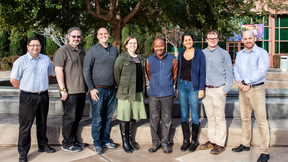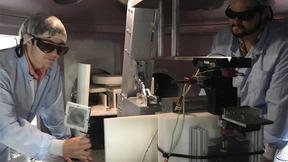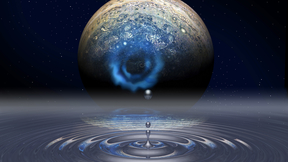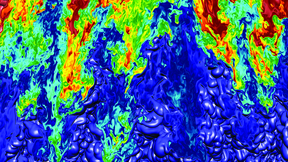Back
High-energy density (HED) science is foundational to the nationally important research conducted by Lawrence Livermore National Laboratory (LLNL) — yet few universities offer programs geared for the study of matter and energy under extreme conditions. And even fewer offer such courses for students attending minority-serving institutions. That’s one reason LLNL, Florida A…
Lawrence Livermore National Laboratory's National Ignition Facility (NIF) and General Atomics engineers have created an inertial confinement fusion (ICF) fuel capsule with a 2-micron-diameter fill tube — and along the way, found a solution to a "Bay Bridge"-like dilemma that could have dramatically slowed the process of fabricating NIF capsules. Last month, NIF conducted…
It was a normal morning for design physicist Madison Martin at Lawrence Livermore National Laboratory (LLNL). At 7:45 a.m., she settled into her classified workstation with a cup of tea to check the results of a numerical calculation she ran overnight. If the calculations proved correct, the experiment she was designing on the National Ignition Facility (NIF) would deliver…
The laser guide star revolutionized astronomy by revealing large swaths of the sky that had previously been unseen from Earth due to atmospheric distortions. Now astronomy is on the verge of another great leap forward. The Extremely Large Telescope, which is expected to see first light in 2024, will have a 39-meter-diameter primary mirror — more than three times the size…
Daniel Clark, leader of NIF’s Capsule Modeling Working Group within LLNL’s Inertial Confinement Fusion (ICF) Program, has been named the winner of the 2018 Ronald C. Davidson Award for Plasma Physics. The annual award is presented by AIP (American Institute of Physics) Publishing, in collaboration with the American Physical Society (APS) Division of Plasma Physics, to…
Philip Adams, chief technical officer for Lawrence Livermore National Laboratory’s (LLNL) National Ignition Facility (NIF), has been recognized with a 2018 Oracle Excellence Award. The annual program recognizes customers and partners for exceptional use of Oracle solutions to accelerate innovation and drive business transformation and value by increasing agility, lowering…
The Nobel Prize-winning research by Donna Strickland, a former staff scientist in Lawrence Livermore National Laboratory's (LLNL’s) Laser Programs Directorate, was instrumental in the Laboratory’s development of a series of groundbreaking short-pulse, high-energy laser systems over the past two decades. Self-described "laser jock" Strickland, who worked at LLNL in 1992, is…
The moment Louisa Pickworth saw the rings of Saturn through her father’s backyard telescope, she knew she wanted to become a scientist to learn "more and more and more." Today, Pickworth, 32, is one of LLNL’s heralded young physicists for her work developing cutting-edge X-ray diagnostics to help scientists learn more about ultrahigh energy physics and inertial confinement…
Four Lawrence Livermore National Laboratory (LLNL) researchers have been named Distinguished Members of Technical Staff (DMTS) for their extraordinary scientific and technical contributions to the Laboratory and its missions, as acknowledged by their professional peers and the larger community. Peter Beiersdorfer and Paul Springer of the Physical and Life Sciences…
A group of NIF & Photon Science summer scholars and visiting graduate students are experiencing the value of teamwork as they conduct experiments at LLNL’s Jupiter Laser Facility (JLF). Jesus Hinojosa, 26, a University of Michigan graduate student, and Matthew Thibodeau, 21, a Rice University undergraduate, joined a team of veteran scientists and researchers to explore…
Swirling dense metallic hydrogen dominates the interiors of Jupiter, Saturn and many extra-solar planets. Building precise models of these giant planets requires an accurate description of the transition of pressurized hydrogen into this metallic substance — a long-standing scientific challenge. In a paper published today by Science, a research team led by scientists at…
In a Proceedings of the National Academy of Sciences (PNAS) "Special Feature" paper published online June 26, Lawrence Livermore National Laboratory (LLNL) and University of Michigan researchers reported on recent experiments and techniques designed to improve understanding and control of hydrodynamic (fluid) instabilities in high energy density (HED) settings such as…
Lawrence Livermore National Laboratory’s (LLNL) National Ignition Facility (NIF) laser system has set a new record, firing 2.15 megajoules (MJ) of energy to its target chamber -- a 15 percent improvement over NIF’s design specification of 1.8 MJ, and more than 10 percent higher than the previous 1.9 MJ energy record set in March 2012. This demonstration shot successfully…
After evaluation by an international peer review group, the L3-HAPLS advanced petawatt laser system has been declared fully integrated and operational at the ELI Beamlines Research Center in Dolní Břežany, Czech Republic. The group assessed the laser performance, determined that all performance parameters have been successfully met -- capable of reaching the 1 petawatt, 10…
Tammy Ma, a plasma physicist at Lawrence Livermore National Laboratory (LLNL), has been named a recipient of the prestigious Department of Energy (DOE) Office of Science Early Career Research Program (ECRP). The program, now in its ninth year, is designed to bolster the nation’s scientific workforce by providing support to exceptional researchers during the crucial early…
Marius Millot was just a child when scientists at the University of Pennsylvania and Los Alamos National Laboratory predicted the existence of superionic water ice using molecular dynamics simulations. This new phase of water is characterized by the liquid-like diffusion of hydrogen ions within the solid lattice formed by the oxygens. For three decades, superionic ice…
An experimental campaign conducted at Lawrence Livermore National Laboratory’s (LLNL) National Ignition Facility (NIF) has achieved a total fusion neutron yield of 1.9e16 (1.9x1016) and 54 KJ of fusion energy output -- double the previous record. Researchers in LLNL’s Inertial Confinement Fusion Program (ICF) detail the results in a paper that will be published this week…
Boiling water traditionally involves adding energy to molecules by conduction, convection or thermal radiation. But Lawrence Livermore National Laboratory (LLNL) scientists and collaborators have figured out a way using an X-ray Free Electron Laser (XFEL) to heat water to temperatures above 100,000 K (179,540 degrees Fahrenheit) and pressures above 1Mbar (1 million times…
Experiments on Lawrence Livermore National Laboratory's National Ignition Facility (NIF) are providing scientists with new insights into the turbulent after-effects of a supernova explosion. The studies also could inform efforts to achieve self-sustaining nuclear fusion on NIF and other high-energy laser systems. When stars of a certain mass collapse and then violently…
Using high-powered laser beams, iron-silicon alloys have been compressed to unprecedented pressures corresponding to the center of a three-Earth-mass extrasolar planet. The resulting measurements of crystal structure and density provide new insights into the nature of the deep interiors of the large, Earth-like planets that have been discovered throughout our galaxy. The…
























